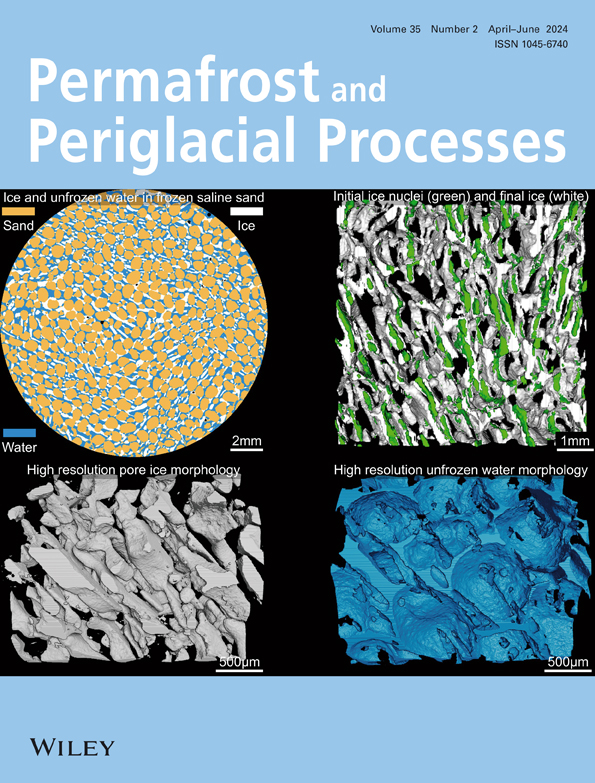Microbial response to warming and cellulose addition in a maritime Antarctic soil
IF 3.3
3区 地球科学
Q2 GEOGRAPHY, PHYSICAL
引用次数: 5
Abstract
Maritime Antarctic King George Island (South Shetland Islands) has experienced rapid warming in recent decades, but the impacts on soil organic matter (SOM) decomposition remain ambiguous. Most vegetation cover is dominated by bryophytes (mosses), whereas a few vascular plants, such as Deschampsia antarctica and Colobanthus quitensis grow interspersed. Therefore, SOM is mainly enriched with carbohydrates and C‐alkyl, provided by mosses, which lack lignin as a precursor for aromatic compounds and humus formation. However, there is no clear answer to how substrate and temperature increase changes in Antarctic microbial respiration. We determined in what way SOM mineralization changes with temperature and substrate addition by characterizing the temperature sensitivity (Q10) of soil respiration in an open‐top chamber warming experiment. We hypothesized that: (a) cold‐tolerant microorganisms are well adapted to growing in maritime Antarctic soils (~ 0°C), so would not respond to low and moderate temperature increases because they undergo various metabolic mechanism adjustments until they experience increasing temperatures toward optimum growth (e.g., by enzyme production); and (b) cellulose, as a complex carbonaceous substrate of vegetated areas in Maritime Antarctic soils, activates microorganisms, increasing the Q10 of soil organic carbon (SOC) mineralization. Soils (5–10 cm) were sampled after four consecutive years of experimental warming for SOC composition, microbial community structure, and C mineralization at 4, 12, and 20°C with and without cellulose addition. Functional group chemoheterotrophs, represented mainly by Proteobacteria, decomposed more refractory SOC (aromatic compounds), as indicated by nuclear magnetic resonance (NMR) spectroscopy, in ambient plots than in warming plots where plants were growing. The C‐CO2 efflux from the incubation experiment remained stable below 12°C but sharply increased at 20°C. Q10 varied between 0.4 and 4 and was reduced at 20°C, whereas cellulose addition increased Q10. In conclusion, as confirmed during field studies in a climate scenario, cold‐tolerant microorganisms in maritime Antarctic soils were slightly affected by increasing temperature (e.g., 4–12°C), with reduced temperature sensitivity, as summarized in a conceptual model.南极海洋土壤中微生物对升温和纤维素添加的反应
近几十年来,南极国王岛(南设得兰群岛)经历了快速变暖,但对土壤有机质(SOM)分解的影响仍然不明确。大多数植被覆盖以苔藓植物为主,而少数维管植物,如南极德尚和奎特科班图斯则零星生长。因此,SOM主要富含碳水化合物和C‐烷基,由苔藓提供,而苔藓缺乏木质素作为芳香化合物和腐殖质形成的前体。然而,对于南极微生物呼吸过程中底物和温度升高的变化,目前还没有明确的答案。我们通过表征开放式温室升温实验中土壤呼吸的温度敏感性(Q10),确定了SOM矿化随温度和基质添加的变化方式。我们假设:(a)耐寒微生物很好地适应在南极海洋土壤(约0°C)中生长,因此不会对低温和中等温度的升高做出反应,因为它们经历了各种代谢机制的调整,直到经历了向最佳生长方向增加的温度(例如,通过产生酶);和(b)纤维素,作为南极海洋土壤植被区的复杂碳质基质,激活微生物,增加土壤有机碳(SOC)矿化的Q10。在连续四年的试验升温后,在添加和不添加纤维素的情况下,在4、12和20°C下对土壤(5–10 cm)的SOC组成、微生物群落结构和C矿化进行采样。如核磁共振(NMR)光谱所示,主要以变形杆菌为代表的官能团化学异养菌在环境地块中比在植物生长的温暖地块中分解更难降解的SOC(芳香化合物)。孵育实验中的C‐CO2流出在12°C以下保持稳定,但在20°C时急剧增加。Q10在0.4和4之间变化,在20°C时降低,而纤维素的添加增加了Q10。总之,正如在气候情景下的实地研究中所证实的那样,南极海洋土壤中的耐寒微生物受到温度升高(例如,4-12°C)的轻微影响,温度敏感性降低,如概念模型所总结的那样。
本文章由计算机程序翻译,如有差异,请以英文原文为准。
求助全文
约1分钟内获得全文
求助全文
来源期刊
CiteScore
9.70
自引率
8.00%
发文量
43
审稿时长
>12 weeks
期刊介绍:
Permafrost and Periglacial Processes is an international journal dedicated to the rapid publication of scientific and technical papers concerned with earth surface cryogenic processes, landforms and sediments present in a variety of (Sub) Arctic, Antarctic and High Mountain environments. It provides an efficient vehicle of communication amongst those with an interest in the cold, non-glacial geosciences. The focus is on (1) original research based on geomorphological, hydrological, sedimentological, geotechnical and engineering aspects of these areas and (2) original research carried out upon relict features where the objective has been to reconstruct the nature of the processes and/or palaeoenvironments which gave rise to these features, as opposed to purely stratigraphical considerations. The journal also publishes short communications, reviews, discussions and book reviews. The high scientific standard, interdisciplinary character and worldwide representation of PPP are maintained by regional editorial support and a rigorous refereeing system.

 求助内容:
求助内容: 应助结果提醒方式:
应助结果提醒方式:


